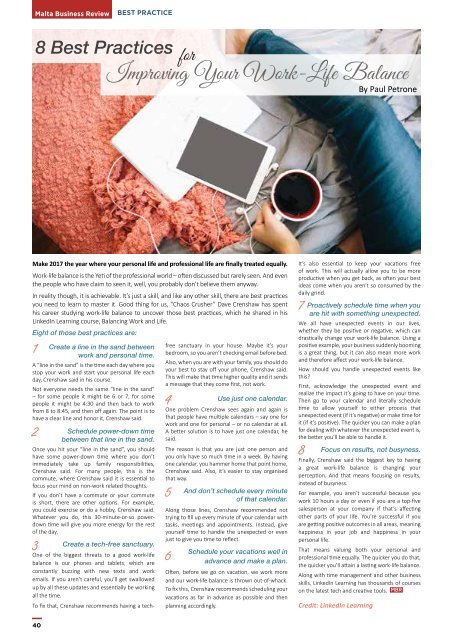MBR_Issue_27 -January 2017 low res
You also want an ePaper? Increase the reach of your titles
YUMPU automatically turns print PDFs into web optimized ePapers that Google loves.
Malta Business Review<br />
BEST PRACTICE<br />
8 Best Practices for<br />
Improving Your Work-Life Balance<br />
By Paul Petrone<br />
MALTA’S BEST ENTREPRENEUR OF THE YEAR AWARDS<br />
SMARTCITY MALTA | FRIDAY, 30 TH JUNE<br />
<strong>2017</strong><br />
MALTA’S<br />
BEST<br />
ENTREPRENEUR<br />
OF THE YEAR<br />
AWARDS<br />
<strong>2017</strong><br />
MALTA’S LARGEST AND INTERNATIONALLY RECOGNISED BUSINESS AWARDS<br />
Make <strong>2017</strong> the year where your personal life and professional life are finally treated equally.<br />
Work-life balance is the Yeti of the professional world – often discussed but rarely seen. And even<br />
the people who have claim to seen it, well, you probably don’t believe them anyway.<br />
In reality though, it is achievable. It’s just a skill, and like any other skill, there are best practices<br />
you need to learn to master it. Good thing for us, “Chaos Crusher” Dave Crenshaw has spent<br />
his career studying work-life balance to uncover those best practices, which he shared in his<br />
LinkedIn Learning course, Balancing Work and Life.<br />
Eight of those best practices are:<br />
1<br />
Create a line in the sand between<br />
work and personal time.<br />
A “line in the sand” is the time each day where you<br />
stop your work and start your personal life each<br />
day, Crenshaw said in his course.<br />
Not everyone needs the same “line in the sand”<br />
– for some people it might be 6 or 7, for some<br />
people it might be 4:30 and then back to work<br />
from 8 to 8:45, and then off again. The point is to<br />
have a clear line and honor it, Crenshaw said.<br />
2<br />
Schedule power-down time<br />
between that line in the sand.<br />
Once you hit your “line in the sand”, you should<br />
have some power-down time where you don’t<br />
immediately take up family <strong>res</strong>ponsibilities,<br />
Crenshaw said. For many people, this is the<br />
commute, where Crenshaw said it is essential to<br />
focus your mind on non-work related thoughts.<br />
If you don’t have a commute or your commute<br />
is short, there are other options. For example,<br />
you could exercise or do a hobby, Crenshaw said.<br />
Whatever you do, this 30-minute-or-so powerdown<br />
time will give you more energy for the <strong>res</strong>t<br />
of the day.<br />
3<br />
Create a tech-free sanctuary.<br />
One of the biggest threats to a good work-life<br />
balance is our phones and tablets, which are<br />
constantly buzzing with new texts and work<br />
emails. If you aren’t careful, you’ll get swal<strong>low</strong>ed<br />
up by all these updates and essentially be working<br />
all the time.<br />
To fix that, Crenshaw recommends having a tech-<br />
free sanctuary in your house. Maybe it’s your<br />
bedroom, so you aren’t checking email before bed.<br />
Also, when you are with your family, you should do<br />
your best to stay off your phone, Crenshaw said.<br />
This will make that time higher quality and it sends<br />
a message that they come first, not work.<br />
4<br />
Use just one calendar.<br />
One problem Crenshaw sees again and again is<br />
that people have multiple calendars – say one for<br />
work and one for personal – or no calendar at all.<br />
A better solution is to have just one calendar, he<br />
said.<br />
The reason is that you are just one person and<br />
you only have so much time in a week. By having<br />
one calendar, you hammer home that point home,<br />
Crenshaw said. Also, it’s easier to stay organised<br />
that way.<br />
5<br />
And don’t schedule every minute<br />
of that calendar.<br />
Along those lines, Crenshaw recommended not<br />
trying to fill up every minute of your calendar with<br />
tasks, meetings and appointments. Instead, give<br />
yourself time to handle the unexpected or even<br />
just to give you time to reflect.<br />
6<br />
Schedule your vacations well in<br />
advance and make a plan.<br />
Often, before we go on vacation, we work more<br />
and our work-life balance is thrown out-of-whack.<br />
To fix this, Crenshaw recommends scheduling your<br />
vacations as far in advance as possible and then<br />
planning accordingly.<br />
It’s also essential to keep your vacations free<br />
of work. This will actually al<strong>low</strong> you to be more<br />
productive when you get back, as often your best<br />
ideas come when you aren’t so consumed by the<br />
daily grind.<br />
7<br />
Proactively schedule time when you<br />
are hit with something unexpected.<br />
We all have unexpected events in our lives,<br />
whether they be positive or negative, which can<br />
drastically change your work-life balance. Using a<br />
positive example, your business suddenly booming<br />
is a great thing, but it can also mean more work<br />
and therefore affect your work-life balance.<br />
How should you handle unexpected events like<br />
this?<br />
First, acknowledge the unexpected event and<br />
realize the impact it’s going to have on your time.<br />
Then go to your calendar and literally schedule<br />
time to al<strong>low</strong> yourself to either process that<br />
unexpected event (if it’s negative) or make time for<br />
it (if it’s positive). The quicker you can make a plan<br />
for dealing with whatever the unexpected event is,<br />
the better you’ll be able to handle it.<br />
8<br />
Focus on <strong>res</strong>ults, not busyness.<br />
Finally, Crenshaw said the biggest key to having<br />
a great work-life balance is changing your<br />
perception. And that means focusing on <strong>res</strong>ults,<br />
instead of busyness.<br />
For example, you aren’t successful because you<br />
work 10 hours a day or even if you are a top-five<br />
salesperson at your company if that’s affecting<br />
other parts of your life. You’re successful if you<br />
are getting positive outcomes in all areas, meaning<br />
happiness in your job and happiness in your<br />
personal life.<br />
That means valuing both your personal and<br />
professional time equally. The quicker you do that,<br />
the quicker you’ll attain a lasting work-life balance.<br />
Along with time management and other business<br />
skills, LinkedIn Learning has thousands of courses<br />
on the latest tech and creative tools. <strong>MBR</strong><br />
Credit: LinkedIn Learning<br />
CELEBRATING<br />
6 YEARS<br />
OF ENTREPRENEUR<br />
EXCELLENCE<br />
INFO<br />
FOR FURTHER<br />
INFORMATION PLEASE<br />
CONTACT<br />
Margaret Brincat<br />
• M: 9940 6743<br />
•<br />
VISION, GROWTH AND PEOPLE<br />
40

















